The world has come a long way. So have its people. At times like these, when the world is going through an absolute slowdown and partial lockdown due to a virus, suffering has always been a synonym for human life. Be it scientific, racial, religious, communal or otherwise.
While most of us are undergoing social distancing and self-quarantine to control the spread of Covid-19, I happen to come across testimonies of suffering that ached my heart.
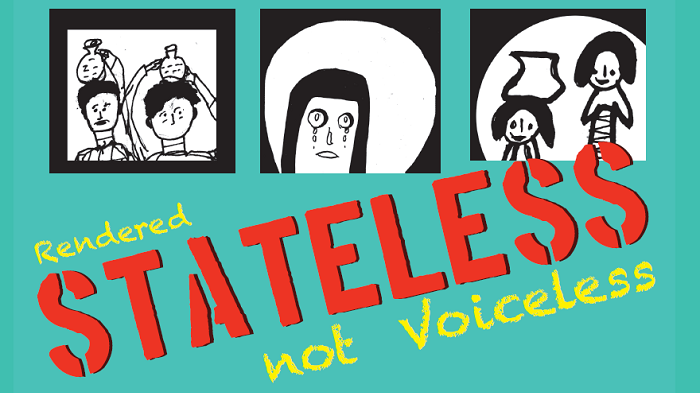
Let me sort out a few examples – Ali Johar, a 10 year old boy, wasn’t allowed to go to school and faced flak. He had to flee his home with his family in Myanmar to find refuge in Bangladesh in 2005. Seven years later, his family moved to Delhi. Cut to Shamema, who’s disgruntled with the dirty shared toilets in the refugee settlement where she stayed with her family.
These are snippets from the comic book, Rendered Stateless Not Voiceless, compiled by World Comics India, that depicts the sad and horrifying conditions of the Rohingya refugees, through grassroot comics.
Rendered Stateless Not Voiceless, is a collective that promotes comics as a communication and empowerment tool for the marginalised, The comic book is an outcome of a workshop conducted by the organisation with around 50 to 60 Rohingya refugees in Kalindi Kunj and Nuh, Mewat.
 The Rohingya refugees are a stateless Indo-Aryan ethnic group who predominantly follow Islam with a minority following Hinduism and reside in Rakhine State, Myanmar. They were denied citizenship under the 1982 Myanmar nationality law, and were also restricted from freedom of movement, state education and civil service jobs. The legal conditions faced by the Rohingya in Myanmar have been widely compared to apartheid by many international academics, analysts and political figures.
The Rohingya refugees are a stateless Indo-Aryan ethnic group who predominantly follow Islam with a minority following Hinduism and reside in Rakhine State, Myanmar. They were denied citizenship under the 1982 Myanmar nationality law, and were also restricted from freedom of movement, state education and civil service jobs. The legal conditions faced by the Rohingya in Myanmar have been widely compared to apartheid by many international academics, analysts and political figures.
The exodus of around one million Rohingyas from Myanmar was an unprecedented crisis, especially for South East and South Asian regions. As per the United Nations High Commissioner for Refugees (UNHCR), 17,500 Rohingya refugees are registered in India, although according to some claims these numbers are as high as 40,000. The work of the UNHCR to protect their rights becomes more difficult as India is not a signatory to the 1951 Refugee Convention. The Government of India terms Rohingyas as ‘illegal immigrants’ and treats them accordingly. The living conditions of Rohingyas in makeshift slums in different parts of the country are appalling. Apart from an unhealthy environment they also have to face hostile behaviour from the local population, police and authorities. On top of that, the fear of being forcefully deported looms large on their heads.
AnimationXpress had a chat with World Comics India founder and cartoonist Sharad Sharma, who explained how it was made possible and why it was necessary. Read on :
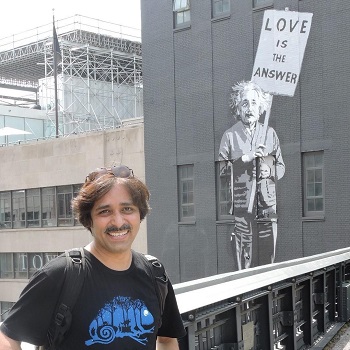
> How did you come up with the idea of compiling comics created by Rohingya refugees?
The goal of this project was to help Rohingya refugees to document their life stories back in Myanmar as well as their current struggle for survival in India. Although a good number of media reports have been published on their condition in India but there are no instances when they themselves were provided an opportunity to express their concerns. Telling your life story to others no doubt is a healing process by itself, but what makes this process more interesting is when the same thing is done with the help of a medium like grassroots comics. Here you neither require your audience in front of you nor seek their immediate response. One has a choice to either reach out to a selected audience after producing the final wall poster-comics by reproducing it through photocopy or make it available in public domain for larger reach.
> How did you collaborate with the creators of the comics?
I was in touch with few youth activists from the Rohingya communities since 2014 and was keeping a close eye on their issues both in India and other parts of the globe. In the last two years there was a plan to do this project but there was no financial support available.
We organised two workshops in Kalindi Kunj refugee camp (New Delhi) : This camp came into existence on 20 May 2012. Approx 50 Rohingya families living here, total population around 225. Most of the people earn livelihood as daily wage labourers, running small shops and stalls, ply rental e-rickshaws. The first two-day workshop was organised on 14 and 15 September, 2019.
The next was Nangali-1 Camp, Nuh, Haryana, where there are several small settlements of Rohingyas in Haryana state of India. Fifty-one families with a total population of around 156 people live in this camp known as Nangali-1. The second two-day workshop was organised on 16 and 17 November, 2019.
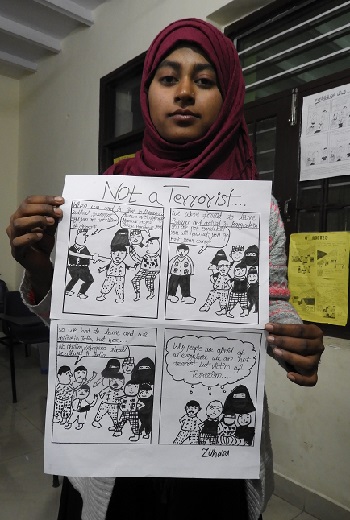 > How has the experience been and how much time it took for you to complete it?
> How has the experience been and how much time it took for you to complete it?
It took almost eight months to complete the project. But the ground work was going on for almost a year.
> How are you planning to distribute it to a wider audience?
Through media reports, online and individual distribution. Already posted over 100 copies across the world. Getting more and more requests everyday.
>Why according to you, art forms and comics are the best medium to talk about serious issues?
Telling your life story to others no doubt is a healing process by itself, but what makes this process more interesting is when the same thing is done with the help of a medium like grassroots comics. Here you neither require your audience in front of you nor seek their immediate response. One has a choice to either reach out to a selected audience after producing the final wall poster-comics by reproducing it through photocopy or make it available in public domain for larger reach.
The idea of grassroots comics is most aptly expressed in our slogan namely ‘Any Body Can Draw,’ (The ABCD of Grassroots Comics). We have been using this methodology for the past two decades and it has proved to be a powerful alternative medium of communication. The grassroots comics are different from mainstream comics created by professional artists, they are creations of common people having no such artistic ambition but a burning desire to express their own self or share their point of view. The simplicity of the grassroots comics approach lies in the fact that it just requires a pen, paper and something to say.
We believe that the process of a grassroots comics workshop is much more important than the final product. The workshops are not just for simply imparting or acquiring drawing skills, but rather focus on how participants can develop an eye for an issue. They learn how to identify the stories, which really matter to them and are close to their heart. They are shown different ways and examples of how to compose an idea, develop a story around it or just tell their life stories or even start by sharing any small incident. This participatory method promotes the sharing of each individual’s ideas that are then discussed among participants, leading to debate inside the workshop hall and later in society.
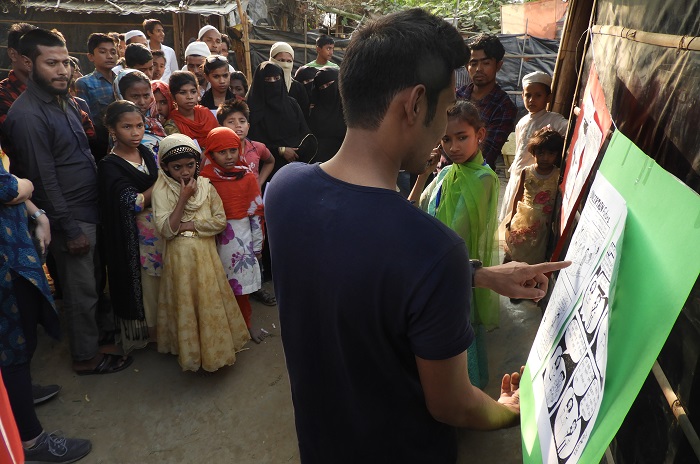
While Sharma emphasised on the healing through creative process, Johar who’s currently an education coordinator of the Rohingya Human Rights Initiative and lives in Delhi pointed out, “A comic book can help us reach out to those who are literate and also others who may not be able to read. It has been a constant struggle. In Myanmar, my father was a businessman with political connections, but in India, we are refugees and have no rights; we can’t buy property, get a government job. But no one can deny us education.”
He was just nine years old when his family was forced to leave their home in Rakhine province in Myanmar, which led him create comics on how the Myanmar Army used to take Muslim youths for forced labour work; anyone who would disagree would be shot at point-blank. In such circumstances, many youths were forced to flee out of the country.
The Delhi workshop saw the emergence of a feeling of the “ownership of the Comics medium”. When the participants were asked to draw their own stories, some of them said, “That is my story told in my way.”
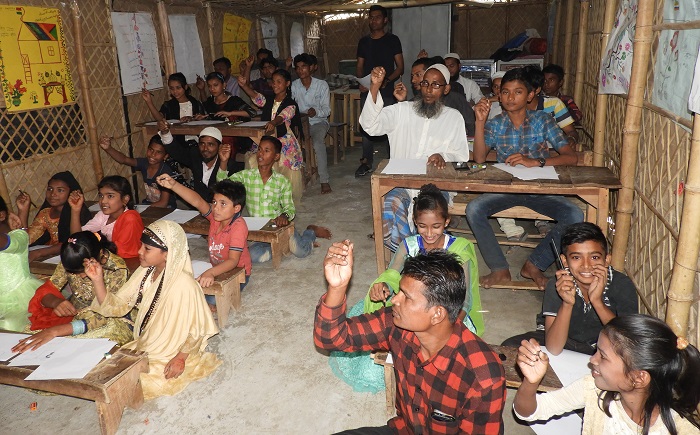
Minutes into the process, multiple stories and narratives began to emerge on each sheet. “This is my school, back in Myanmar!” “This is me and my friends, going on the road. These are the trees back in Burma!,” said one.
“This is me, and my sisters and this is our home! Here we are stopped by Burmese police and not allowed to go since we don’t had any permit,” said another.
Further discussions on these comics would loosen up the participants who’d share, relate and emphasis with each other. “This has happened to us too!”, “We go through this as well!” “Wait, isn’t this what happened to us too!?” such sentences were muttered.
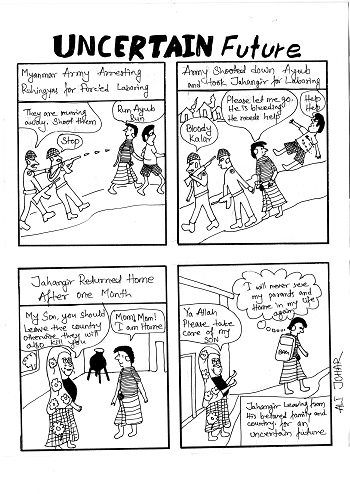 One after another participants started telling stories of their past, communities and harsh life in the refugee camps, struggle for survival, language barrier, lack of empathy and fear of being deported. Since the workshop was happening in the middle of the camp it became the centre of attraction for all the kids who camped all the time at the gate of the workshop venue.
One after another participants started telling stories of their past, communities and harsh life in the refugee camps, struggle for survival, language barrier, lack of empathy and fear of being deported. Since the workshop was happening in the middle of the camp it became the centre of attraction for all the kids who camped all the time at the gate of the workshop venue.
The most curious were two elderly participants – Azizullah (70) and Md Tayyab (65) who contrary to my expectation drew their stories overnight. They were keen to show it to me as if they wanted to make sure if what they did was on the right track.
The reliability of grassroot comics around the world, sometimes from across the globe, shows how some experiences and stories are common and unite people in their shared sense of struggle and hope. Issues such as bad healthcare, harassment in homes and public spaces, exclusion and discrimination are felt and the participants rise up to discuss these issues as they have faced them in their lives. And Rendered Stateless Not Voiceless gives them the voice that had been long curbed.
